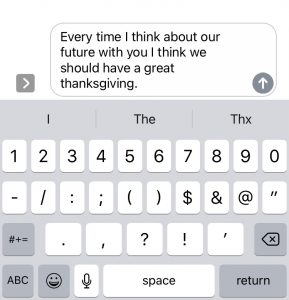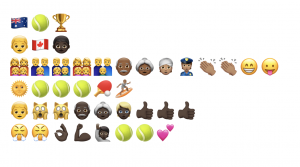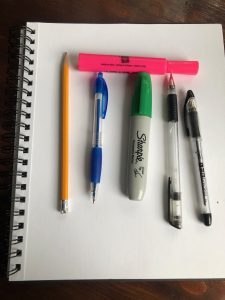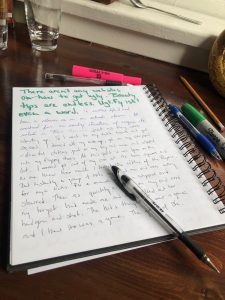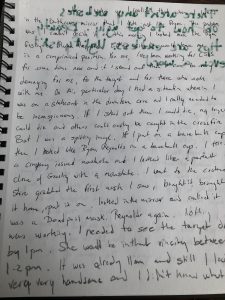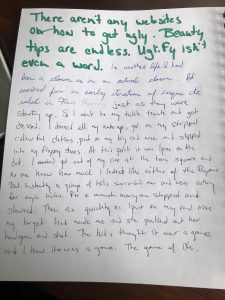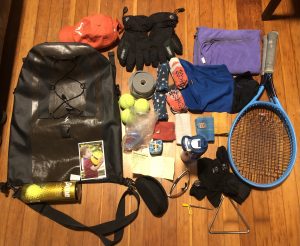Jennifer R
An Emoji Story
https://blogs.ubc.ca/etec540jenniferr/2021/02/21/task-6-an-emoji-story/
I agree with Jennifer as far as being stuck in conventions of language and how we communicate meaning. There seems to be a logical progression in communication through language or oral communication. But we almost have to throw those conventions out when we use something new like the emoji. What is an emoji? How does it disrupt the way we tend to communicate through the written word. I’d be curious to do this assignment on a few different layers. Try it once with no words (as we did) then try to layer in a bit of writing and then a bit more. I look at Jennifer’s emoticons and fixate on the first line where there appears to be something that looks like a curling rock. And I can’t shake it. I don’t think the TV show actually has anything to do with curling but I keep coming back to that as I study it.
Her use of repetition could be very successful if I knew what show or even if I was in the right ballpark as to what she was trying to communicate. The emphasis is great and I was totally clear that someone wasn’t happy at the very end.
Manize
What’s in Your Bag
https://blogs.ubc.ca/etec540manizenayani/2021/01/20/task-1-whats-in-my-bag/
I spent a fair amount of time looking at many of my classmates ‘Bag Photo’ projects. I found that there were a lot that just kind of spilled things out of a bag and took a quick picture. I finally came across Manize’s bag picture and I was impressed by how detailed it looked. There was a lot of attention to the way things were placed, the decisions that were made in the combinations, and the framing of the shot. Interestingly I didn’t know the gender of Manize. I’d played tennis when I was young with a guy named Manize so I thought it was a he. I first saw the Game of Thrones book and then I thought there were two condoms in the middle of the picture. Ok?? Umm really. I looked more closely and the name of the product was strepsils…hmmm. OOOh right. It’s just a lozenge. Then I saw lipstick beside the lozenges and I thought ‘oh maybe this isn’t a dude!’ No judgement if the fella wants to wear lipstick but I think I started to put together that it was a woman and not a man. I loved the colour of the glasses case and how it popped in the picture.
Now – should this be the new tinder? I know the question sounds facetious but bear with me for a moment. We are all creating our digital selves online. Do our digital selves equal who we truly are? Now most of us don’t know who we truly are and so that digs into another level of existentialism. I won’t go there but let’s stay with the concept of ‘our digital selves.’ There is a digital curiosity to this exercise. Manize shows that she goes to the library, she drives a modest car, and she has a sense of style. This exercise might show more about who she truly is then even some of the exercises that we do to introduce ourselves in this program.
Olivia M
Voice to Text
https://blogs.ubc.ca/omarin/2021/01/26/voice-to-text-flaws-and-fortes/
I’ve read a few novels recently where the author played with the rules of punctuation. In particular in one of the books didn’t use quotations to indicate that a person was speaking. I wondered why did they choose to do this. At times I wasn’t sure if they were speaking aloud but as the novel went on I began to find the context of their speaking and it became natural and clear when a character spoke. I think perhaps the author did it because they wanted the reader to be more conscious as they read. And I suppose it simply has us ask the question – why punctuation? In reading Oliva’s story I found that I was torn between loving punctuation and kind of shrugging and thinking maybe it’s not necessary and maybe it enhances things by not having it in there. I found that I could hear her voice more clearly. I heard tone and intonation in a way that I hadn’t before.
I agree with her that the amount of coding necessary to successfully create voice to text is astounding. How did anyone even think it could be done? I wonder where the idea for it germinated? Did they think of all of the implications? Did they consider people who have slurred speech or speech impediments? Will there be continued work to improve this to help draw those in who are left on the sidelines? What about accent and those who have an accent that the program doesn’t recognize.
Olivia highlighted the challenges that she faced when she attempted to use french within her story about french. Ironic. Or is it ironique? And would voice to text be able to tell the difference?
Anne E
https://anneemberline.com/edu/task-7-mode-bending/
Mode bending
Anne’s exercise in mode bending is mind bending. Wow. Well done. Lots to think about and digest. On first glance and read through it is clear that she had a good time expressing herself by playing with different mediums and looking at how to express herself in alternative ways. I wonder if there is something here? IE how much does the enjoyment of communication help with the clarity of communication? In other words that person who loves to lecture, does that love of the format help with their ability to convey the idea? Of the videographer who films the video and loves to do it, does that make the communication better? I think so. I think we can tell when a person enjoys the way that they communicate. The person who loves to tell a joke to a group of people, we enjoy it that much more when we can tell that they’re enjoying telling it and that they’re comfortable in that joke. And so with Anne’s post. It is evident that she dove headfirst into this assignment and enjoyed it and that helped with conveying a clear message.
It’s interesting how the different modes of communication helped to further explore who she is as a person and to express her identity in similar and very different ways.
Infographics – hilarious. And then some! Emotional connection to her various things- love it. But it does also help to shape and tell the story. The humour also comes out quite clearly and which further shapes her character or at least what we begin to think her character is by this exploration.
The curation of songs and videos was an inspired method for self expression. It worked in a two fold way where it showed some of her preferences and helped to continue to tell the story. I particularly enjoyed the history of the tampon and thought it a good thing to not shy away from but instead be bold about.
I’ve continued to deepen my thoughts on identity in this course. Particularly in how we marry our physical/mental self to the digital self. Who am I and how do I self actualize but then two how do I self actualize in a digital me. I think Anne has done a cool job of demonstrating her digital self in this exercise. If she’s half as interesting as her digital self then I hope I get a chance to meet her sometime! Well done Anne!
Lori J
Golden Record
It is so amazing to see how different people approach these different exercises. Lori weaved in so many great videos into her writing. It never dawned on me to do something like this. The curation of web content is another skill in communication. How do we search for content that is appropriate and what is needed? How do we weave that into our own content? The ‘Secret Rules of Modern Algorithms’ illuminated some ideas that had been brewing inside of me. I guess with this assignment I wasn’t entirely sure how algorithms are a mode of communication. But after watching these videos, reading Lori’s post and ruminating on my own ideas it became clearer and clearer what they are and how they communicate things. Algorithms are simply a way to mine, synthesize and explain data. Patterns emerge. Now the patterns that emerged don’t tell the entire story. However the patterns start to tell the story and then we can begin to surmise what follows. The questions that Lori was asking were similar to mine. So there are a few outliers. We don’t know why the songs are outliers but we can at least see that they are outliers and then we can consider why that is the case. It’s interesting in that one of the songs that I chose was one of the outliers. I know that I took the bold or foolish approach to simply select randomly. Now that one of my random selections was an outlier. Painfully for others if they were trying to logically figure out that outlier it might never come to them that someone had simply chosen randomly. The question remains though, why did no one else or so few choose that particular song? Who is the group of people choosing? What are their variables? There are so many variables but we at least have the information from the algorithm to begin to sort out the whys to the selections. Again the thing that stood out for me in Lori’s post was the mix of writing and curation of other videos to shape her ideas. I look forward to trying this concept myself at some point.
Selina C
Attention Economy
https://blogs.ubc.ca/sellina14etec540/2021/03/20/task-10-attention-economy/
Annoying. Annoying. Annoying. This was a recurring theme for Selina and I for attempting to complete this ‘game’ online. I put game in quotes because generally games are supposed to be fun. I tried to find it fun but I never managed to achieve any degree of fun. More pain than fun. I think Selina was in the same camp that I was. It was nice to read her post because it made me realize that I wasn’t alone in the struggles that I faced with this exercise. She brings up some great points and similar ones to the ones that I discovered. This idea of ‘dark patterns’ on the web is concerning. How to monitor those things for ourselves? How do we understand that they are taking place? Even as I write the part of my blog I’m using Google Docs. Is this a good decision? Is Google capturing data about me at the present time? Maybe it’s fairly innocuous data like – Peter Jordan spends 1 hour 12 minutes on Google Docs as he slowly writes. But what can Google do with that information? Maybe there isn’t much. But maybe the isn’t much is just at the present time. When we think of 10 years ago gmail became a thing…oh isn’t that nice Google is giving away free email addresses. Without a catch? There’s always a catch. So what’s the catch? Perhaps that is the question that we need to return to over and over again. If I click on this, then what is the catch? If I linger on this website, then what is the catch. If I accept the cookies (as Selina stated she never does), then what is the catch? The digital catch. Nice catchphrase. Selina also mentioned the concept of digital literacy. This course has opened my mind to the meaning of digital literacy. There is so much that we interact with and do online where we don’t know the mechanisms behind those things. The curtain needs to pulled back to realize that perhaps it’s not as complicated as we all think. I know that I hear the words computer science and I just assume it’s out my depth and I won’t be able to understand it. We must know what lurks behind the surface in the digital realm otherwise we’ll be pulled into things and will remain in a place of ignorance. I also feel it important to comment on the title of this exercise as ‘Attention Economy’. Aptly titled and we must consider where we place our attention. Our collective attention seems to lend itself to a digital adhd…so I guess that makes it a DADHD – digital attention hyperactivity disorder.

